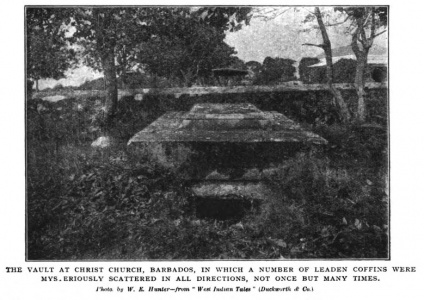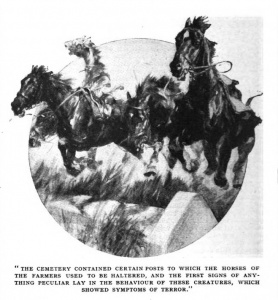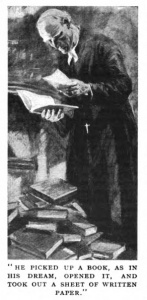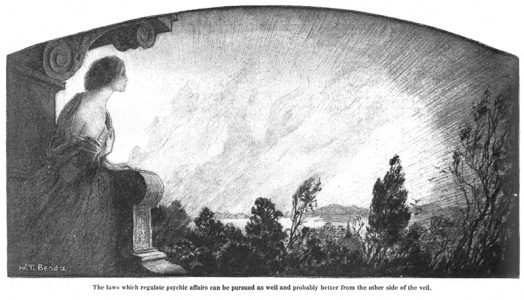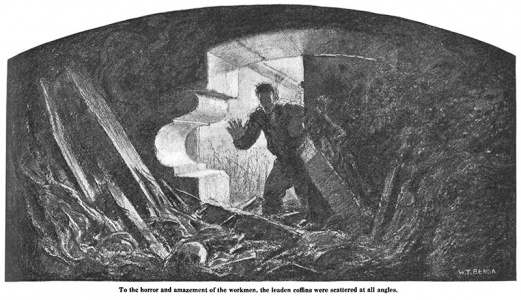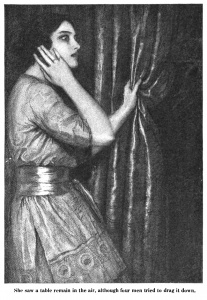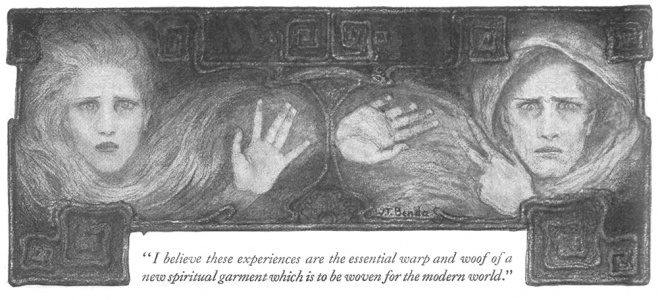The Law of the Ghost
The Uncharted Coast - I. The Law of the Ghost is an article written by Arthur Conan Doyle first published in The Strand Magazine in december 1919.
Editions
- in The Strand Magazine (december 1919 [UK]) 3 illustrations by Howard Elcock, 1 photo
- in Hearst's (january 1920 [US]) as True Ghost Stories. I. The Christchurch Vault. The Hearse Horses of Ahrensburg (3 ill. by W. T. Benda)
- in Hearst's (february-march 1920 [US]) as True Ghost Stories. II. A Cottage in Hampshire (1 ill. by W. T. Benda)
- in The Edge of the Unknown (1930)
Illustrations
- Illustrations by Howard Elcock in The Strand Magazine (december 1919)
-
-
-
-
-
- Illustrations by W. T. Benda in Hearst's (january-march 1920)
-
The laws which regulate psychic affairs can be pursued as well and probably better from the other side of the veil.
-
To the horror and amazement of the workmen, the leaden coffins were scattered at all angles.
-
She saw a table remain in the air, although four men tried to drag it down.
-
"I believe these experiences are teh essential warp and woof of a new spiritual garment which is to be woven for the modern world."
The Uncharted Coast - I. The Law of the Ghost








It is safe to say that for some centuries to come the human race will be very actively engaged in defining the laws which regulate psychic affairs, and it is fortunately a line of study which has the peculiar advantage to those who indulge in it that they can pursue it just as well, and probably better, from the other side of the veil. At present there is work lying to hand for a hundred investigators. The innumerable records which exist in various forms, and which are scattered throughout papers, magazines, reports of learned societies, family traditions, etc., are like masses of ore which have been extracted from the ground but are still lying in dumps waiting to be separated into precious ingots on the one side and slag-heap on the other. They have to be examined, collected into classes, reviewed in the light of our ever-increasing psychic knowledge, and an endeavour made to find underlying principles running through this vague collection of matter, so that at last we may touch solid ground by getting hold of some elementary laws. The first thing is that we should have authentic cases, so that the foundation of our reasoning may be sound. The second is to compare these authentic cases together and see what common characteristics they possess, shirking nothing and following the facts wherever they lead without any preliminary prejudice. This is, of course, the true scientific fashion, but it is unfortunately one which has been neglected by most scientific men in approaching this new subject which would not fit in with their preconceived ideas. Let us bunt among these fascinating problems for shards and splinters out of which a noble mosaic will one day be constructed, and let us see whether here and there we may not find two or three pieces which fit together, and give some idea of a permanent pattern, even though it be a fantastic one. I will begin by telling three stories which seem to be absolutely authentic, and then we shall endeavour to trace some underlying connection.
For full particulars of the first case the reader is referred to "West Indian Tales," by Algernon Aspinall, with the explanation that the word "Tales" is not used in the sense of inventions and that the facts are authentic, as is proved by numerous references in the narrative. These facts relate to the singular series of events which happened in connection with the vault at Christchurch, near the village of Oistin, on the south coast of Barbados. In the old slave days, when rum and sugar were the foundations of many a goodly fortune, things were done on a large scale in the West Indies, and this burial vault was a very fine one. It was made of great blocks of coral and cement, partly sunk into the earth, for the graveyard was on an exposed hill, and terrific storms sweep over those latitudes. The entrance was covered by a huge slab of marble. Within, the dimensions of the vault were twelve feet by six and a half. So Cyclopean was the masonry and so remote the site that one would imagine an inmate was almost as secure as a king of Egypt in the heart of his pyramid. A contractor and a gang of skilled workmen would be needed to effect an entrance into so solid a construction. Little did those who erected it imagine that the whole island would be convulsed by the repeated proofs of its insecurity.
In July 1807, a Mrs. Goddard was buried therein, and her coffin was found undisturbed in February, 18013, when a child named Mary Chase was laid in a leaden casket beside her. For years the vault was closed, but on July, 1812, it was opened to admit a Miss Dorcas Chase. The horrified workmen found the coffin. of the infant standing on its head in a corner. It was supposed that some mischievous and sacrilegious wretch had been guilty of a senseless outrage ; so after the coffin was rearranged the great marble slab was once again placed in position, to be opened next month when a Mr. Chase joined the family group within. During the month there seems to have been no disturbance.
In September, 1816, four years having again elapsed, the vault was opened once more to admit an infant, Samuel Ames. Once again all was in horrible confusion, and the coffins littered across one another. The affair was now becoming a scandal and the talk of the whole settlement — the whites putting it down to vandalism and the negroes to ghosts. Once again the vault was closed, and once again, two months later, it was opened to admit Samuel Brewster. Crowds followed the coffin and gathered round the vault when the great slab was pushed aside. In the short interval everything had again been disarranged, the coffins being abominably mishandled. Mrs. Goddard's coffin, which seems to have been of wood, was broken. but this may have been natural decay. The leaden coffins were scattered at all angles. Once again they were reverently collected, the wooden coffin was tied up, and the vault secured.
Three years later, on July 7th, 1819, Miss Clarke was to be buried in the vault. So great was the public excitement that the Governor. Lord Combermere, of Peninsular fame, attended the ceremony with his staff and aides-de-camp. Things were as bad as ever. The wooden coffin was intact, but the others were scattered in all directions. Lord Combermere was so interested that he had the whole structure searched and sounded, but there was no hidden approach or underground passage. It was an insoluble mystery, The coffins were rearranged, and the floor carefully sanded, so that footsteps would be revealed. The door was cemented up, which seems to have been done on each occasion, but this time the Governor affixed his own particular seal. The British Government had officially entered the lists against the powers of darkness.
It is humiliating to add that the powers of darkness seemed not in the least abashed either by the Governor or by the Empire which he represented. Next year, in
Illustration: SITUATION OF THE COFFINS WHEN THE VAULT WAS CLOSED, JULY 7, 1819.
Illustration: THEIR SITUATION WHEN THE VAULT WAS REOPENED, APRIL 18, 1820.
From "West Indian Tales" (Duckworth & Co.).
April, 1820, it was determined that an official inspection should be made without waiting for a fresh interment. Lord Combermere, with a formidable official party and a strong ally in the Rev. T. Orderson, rector of the parish, repaired to the vault, where the seals were found intact and all in apparent order. The cement was then broken and the slab removed by the exertions of ten negroes, who had the utmost difficulty in forcing an entrance. On exposing the interior it was found. to the horror and amazement of the party, that the difficulty in opening the vault had been caused by the fact that a leaden coffin within, so heavy that several men could hardly move it, had been jammed upside down against the slab. There was great confusion within, but no marks upon the sand which covered the floor. So horrified was everyone by this final test, that the bodies were now removed and buried elsewhere. The empty vault remains, and is likely for many centuries to remain, as a refuge for snakes or centipedes, upon the lonely headland which overlooks the Atlantic.
What is one to make of such a story as that ?
The facts seem to be beyond question. Are there any points which are particularly to be noted from a psychic point of view, in the hope that the germs of law may lie within ? One is that the antipathy of those unseen forces was aroused apparently by the leaden coffins. When the wooden coffin was alone it was not molested. Its decay seems to have been natural, and when it was tied up it was not again disturbed. If it ever received any injury, it may well have been from the weight of the ponderous leaden coffins which were dashed about around it. That is one possible point. A second and more important one is that all psychic phenomena seem to show that the disembodied have no power of their own, but that it is always derived from the emanations of the living, which we call animal magnetism or other names. Now, this vault with its absolutely air-tight walls was particularly adapted for holding in such forces being an exaggerated form of that cabinet which is used for that very purpose by a genuine medium. If the walls of cloth of a. cabinet can contain these emanations and condense them, how much more the solid walls of his vault ? To bring in these weighty leaden coffins, the space must have been crowded with overheated negroes ; and when the slab was at once hermetically sealed. these effluvia were enclosed and remained behind, furnishing a possible source of that material power which is needful for material effects. These are two points worth noting before we pass on to see if any other such cases may fall into line with this one.
Photo: THE VAULT AT CHRIST CHURCH, BARBADOS, IN WHICH A NUMBER OF LEADEN COFFINS WERE MYSTERIOUSLY SCATTERED IN ALL DIRECTIONS, NOT ONCE BUT MANY TIMES. Photo by W. K. Hunter — from "West Indian Tales" (Duckworth & Co.).
We have not far to seek, for one is quoted in the very book under discussion, with a reference to the European Magazine for September, 1815, under the heading. "The Curious Vault at Stanton, in Suffolk." In the magazine account it says "On, opening the vault some years since, several leaden coffins with wooden cases that had been fixed on biers were found displaced, to the great astonishment of many. The coins were placed as before, when some time ago, another of the family dying, they were a second time found displaced. Two years after, they were found not only all off the biers, but one coffin, as heavy as to require eight men to raise it. was found on the fourth step that leads into the vault." There, unhappily, the information ends. It tallies very closely with the West Indian case so far as it goes, but is far weaker as regards the evidence and the details. I have made inquiry from the present vicar of the parish, but have been unable to improve either the one or the other. The statement that the phenomenon occurred twice and the precise information as to the situation of the coffin upon the fourth step of the stair seem to remove the story from vague rumour, and to show that it was based upon some actual fact.
The next case, however, is fuller and more circumstantial.
It comes from the Livonian village of Ahrensburg, in the Baltic, and, remote as the scene is, the evidence is well attested. There is a considerable cemetery in the village, which is dotted with small private chapels, each of them with a family burial vault beneath it. The finest of these belonged to a family named Buxhoewden, which faced the public high road, and contained certain posts to which the horses of the farmers used to be haltered when the owners were occupied in the town. The first signs of anything peculiar lay in the behaviour of these creatures, which showed such symptoms of terror that they attracted the notice of passers-by. They were covered with sweat, trembled all over, and in three cases actually died from the violence of their emotion. At the same time, certain loud but vague sounds were heard to come, either from the chapel or from the vault beneath it. These portents were in the early summer of the year 1844.
In July a member of the Buxhoewden family died, and the hearse homes, on approaching the cemetery, showed the same signs of terror as the others. The service in the chapel was interrupted by hollow groans, which may have been imagined by a congregation who were already predisposed to alarm. What was nut imagination, however, was the fact that those who afterwards descended into the vault found the coffins there, which had been in rows, cast into a confused heap upon the wooden floor. These coffins seem to have been of massive oak, very strongly and heavily made. This might have been the work of some enemy to the family, but the doors of the vault had been secured and the locks were intact. There was always the possibility of false keys, however, so the coffins were replaced in their original order and the place very carefully secured.
As the agitation of the horses and the general unrest of the community still continued, the chief man of the district. Baron de Guldenstubbe, took up the matter officially, and so the Russian Government found itself involved in the same one-sided contention from which the Governor of Barbados had gained so little satisfaction. With two of his family, he made a preliminary examination, and then, finding the coffins once again in confusion, he formed a committee of investigation consisting of himself, the local Bishop, the Burgo meister, a physician named Luce, and four representative citizens.
Illustration : "THE DOOR OF THE VAULT WAS CEMENTED UP, BUT THIS TIME THE GOVERNOR AFFIXED HIS OWN PARTICULAR SEAL."
On entering the vault, they again found that the enemy had been at work, and that the contents were scattered in all directions. Only three coffins, those of a very saintly grandmother and of two little children, were undisturbed. Attempted robbery was suggested as an explanation, which was the more plausible as an adjoining vault had once been entered and some gold fringe taken from the coffins. But nothing was now missing, nor was there any means of entrance. The committee pursued its research with great care, even to the point of opening some coffins to see if rings and trinkets buried with the owners were still within. It was found that this was so. Workmen were then called in to examine the floor and walls, but no secret entrance could be discovered.
Everything was now closed up once more and the disconsolate committee withdrew, after placing heavy seals upon the door. Before leaving the vault fine ashes were scattered all over the wooden floor, and also over the steps leading down, and the pavement of the chapel. Finally, guards were set for three days and nights. It must be admitted that they did things thoroughly in the village of Ahrensburg. At the end of that time the commission returned in full state, with the whole population lining the churchyard rails, eager to hear the result.
The seals were unbroken, the door unopened, but the interior of the vault was in the usual state of chaos. No signs were found upon the ashes, and no human feet had entered, but great forces had, none the less, been at work. The secret powers, reinforced rather than abashed by the recent visit of the commission, had wrought far greater mischief than before. All the coffins were scattered, save the same three which had been exempt before. Some of the heaviest had been placed upside down, so that the corpse was on its head, and in one instance the lid had burst and the right arm of the inmate, who was a man who had died b his own hand, was protruding and pointing towards the ceiling. Such was the fearsome spectacle which greeted the commission. They were duly noted in a detailed report, and are still to be consulted among the official records of the island of Oesel, with the names of the witnesses attached.
It is also on record that the effect upon the mind of Dr. Luce, who was a man of considerable attainments and a Voltairian in religion, was a complete change of mental outlook and that revulsion from materialism which any actual contact with the spiritual world, even in its crudest forms. must logically produce.
The result of these gruesome phenomena was that the coffins were removed from the vault and were buried in earth, after which complete tranquillity seems to have descended upon the little village. Not only were there no disturbances to vex the population, but the horses were observed to occupy their old stance without any symptoms of terror. Nothing was left of the whole incident save a memory, but it was a memory which should not be allowed to die, for the facts are really as well attested as facts could be. Apart from the official record, Mr. Dale Owen, who was American Minister to Naples, and a man of great intelligence, met Miss de Guldenstubbe and her brother in 1859 and took their personal recollections of the whole matter. It is from his work that I have taken the details.
No doubt many other such cases could be recorded, but here at least are three which appear to be authentic, and which reproduce the same characteristics. If relics of some strange animal were found in three different localities, the first conclusion among. men of science would be that such ail animal did exist, and was henceforth to be included among the creatures of earth. The next proceeding would be to compare the relics and to endeavour to reconstruct some. image of the new corner. In the same way, these three cases may be said fairly, to establish the fact of these curious phenomena which involve the desecration of graves — a fact which, however gruesome, does at least strike at the very, roots of that material view of life which has been so fashionable. When we come to compare the casks, however, and to deduce the underlying laws, the psychic student can at best only point to a few possible indications which may be of value.
It has already been stated that one or more living people in a confined space which is afterwards closed up may leave behind them something human and yet invisible, which is sufficiently subtle to be used , by forces from the other side as a basis for material phenomena. All movements of solid objects, touched or untouched, in the presence of a medium are to be explained in this fashion, and the force may be expected to be stronger when confined within a limited space. In the case of the Cheriton dug-out, which occupied public attention a couple of years ago, the worker and the boy were busy in a narrow excavation. One or the other was mediumistic — that is to say, emitted to an unusual extent this emanation — with the result that the phenomena occurred in the same way, though with less force, when both of them had left the work for their luncheon, as Mr. Jaques, the owner of the property, was able to testify. Let us suppose that in the case of each of these three vaults there was an accumulation of this mysterious, but very certain power left behind by the coffin-bearers, and possibly reinforced by the committees of inquiry, who would have been very amazed had they been told that they were, in all probability, themselves contributing to the phenomena. There, I think, you have the physical basis which is necessary for every spiritual manifestation, for it cannot too often or too clearly be insisted upon that spirits are not omnipotent and irresponsible forces, but that they are under a rule of law no less strict than our own. One of these laws is that a physical basis is needed for every physical manifestation. We may find in the future some non-human basis, for it is conceivable that some subtle chemical action could be established which would generate this magnetic force,. just as zinc and acid generate the kindred mystery of electricity. But a physical basis there must No ghost was ever self-supporting. He can exist without our help, but he cannot manifest to human eyes without drawing his material from human (or possibly animal) sources. That, as it seems to me, is one of the basic laws of the new world of science.
There is some evidence, which could be cited in full if it did not lead us down a lengthy side street, that when a life has been cut short before it has reached its God-appointed term, whether the cause be murder or suicide (of accident I speak with less confidence), there remains a store of unused vitality which may, where the circumstances are favourable, work itself off in capricious and irregular ways. This is, I admit, a provisional theory, but it has been forced upon my mind by many considerations, and especially by an inquiry which I conducted myself where a series of childish and apparently senseless physical phenomena ended in the discovery of the body of a child in the adjacent garden. Such a theory would go some way to explain, or at least to throw some dim light upon, the disturbances which from all past time have been associated with scenes of violence and murder. If it could be conceived that the unseen part of a man is divisible into the higher, which passes on as spirit, and the lower, which represents animal functions and mere unused vitality, then it is this latter which has not been normally worked off in a life prematurely ended, and which may express itself in strange semi-intelligent fashion afterwards. In dreams one is conscious of some such division, where the higher functions occasionally bring us back touches of the most spiritual, while the lower functions, deprived for the time of judgment, humour, and all the spirit qualities, evolve a capricious and grotesque life of their own, which has neither reason nor sense of proportion, and yet seems very real to us in our slumbers. It is not a subject upon which one could be dogmatic, but the days are passing when all such cases can be disposed of by being brushed aside and ignored as senseless superstition. Some sort of framework must be formed into which they can be fitted, and with fuller knowledge the fit will be closer.
Finally, the question arises — What was the object of such phenomena ? We see that the result in at least two cases out of three was that the dead were buried elsewhere. Apparently for some reason the earth burial may have been desired instead of the seclusion of the vault. It would certainly hasten the absolute decomposition of the body, if that should be good from the point of view of the other world. This seems a far-fetched supposition, and one very much at variance with the belief of those numerous nations who have practised the art of embalming and corpse-preservation ; but if this was not the object of the disturbance, it must be admitted that it is difficult to see what other result was attained, save a very compelling proof of unseen intelligences and powers. If a speedy decomposition was the object aimed at, then the leaden and heavy oak coffins would check the process, which would be swifter in the more fragile wooden ones. This might conceivably explain the particular violence which seems to have been used towards the more permanent materials. Perhaps, however, we lose time in searching for rational explanations, since there is ample evidence that there can be rowdiness and hooliganism beyond the veil as well as here.
"THE CEMETERY CONTAINED CERTAIN POSTS TO WHICH THE HORSES OF THE FARMERS USED TO BE HALTERED, AND THE FIRST SIGNS OF ANYTHING PECULIAR LAY IN THE BEHAVIOUR OF THESE CREATURES, WHICH SHOWED SYMPTOMS OF TERROR."
One remark should be made before passing on to another form of ghostly manifestation. It has been said that the basis for physical results lies ill the human organism. It is not meant, however, that there is any relation between the small amount often taken from the medium and the great physical results obtained. It is clear that the unseen forces can get great power from a limited supply of this subtle material. In the case carefully observed and noted by Professor Zollner, of Leipzig, a beam of wood which two horses could not have dragged apart was shattered into pieces against the grain in the presence of Slade. A friend of mine who was present at a meeting of the Goligher circle saw a table ascend in the air and remain there, although four strong men did all they could to drag it down. It is true that in a sitting of this sort the medium, Miss Goligher, frequently registered a loss of weight amounting to a stone in a seance, upon the weighing dial which Dr. Crawford had erected ; but it is clear that the force exerted by the unseen powers was very much greater than this and was due to their own manipulation of the material which her organism had provided. In some of the sittings of D. D. Home the force was so great that the whole building used to shake as if a heavy train were passing below it.
And here comes one of the mysteries which bear directly upon that definition of spirit law which is so desirable. In spite of the possibility of using vast power, there is a clear and, so far as credible records go, an unbroken ordinance that a ghost may not for its own. personal ends destroy anything or injure anyone. This may seem in contradiction to the broken coffins, but that may not have been for personal ends, but an accident due to the falling about of the heavy weights. Here is an authentic case in illustration.
A great friend of mine, a Roman Catholic priest, whose word could not be doubted by anyone who knew him, was sent for a rust cure to a lonely house upon the coast, which was frequently used by other .priests for the same purpose. Saxe for an old crone and one or two charitable visitors, he was absolutely alone. After a few days he became conscious of strange noises in the house, which at last reached such a point that, to quote his own description, "it sounded at night as if there were a steam-engine snorting and clanking in the room below." Nothing was visible, but the sounds were incest, and were heard by two visitors as clearly as by the inmate. The priest is himself open, more than most men to psychic impressions, and upon that night he had a dream or vision which was so absolutely clear that he determined to act upon it. He descended in the morning and asked the old woman whether there was not an unused room in the basement. She answered that there was. He entered it and found that he had already seen it in his dream — a small, dusty, cobwebbed place, with some old books of theology heaped in the corners. He walked at once to one of these heaps, picked up a book, as in his dream, opened it, took out a sheet of written paper, glanced at it to make sure that it was really as revealed, and then carried it into the kitchen, where he stuffed it between the bars of the grate. The paper was a written preparation for confession, made out by some overconscientious or over-methodical inmate of the house, who had noted down a good many more things than were desirable for public perusal. Presumably he had died shortly afterwards, and had been worried by the recollection of this document, which he had taken these means to have destroyed. There were no further disturbances of any sort within the house.
Now, here is a story which is undoubtedly true, and which cannot be met by any of the ingenious explanations of the honest but sceptical researcher. If the subconscious knowledge of my friend could have told him that the paper was there, it certainly could not have caused the noises which alarmed him. It has to be examined as a fact, as the zoologist already quoted would examine the skin of his rare animal. The unhappy spirit could apparently draw power either from the old housekeeper, or, as is more likely, from the young and psychic priest, to shake the very house with vibrations, and yet, with all this power, he could not destroy a frail sheet of paper, but had to bring its destruction about in this indirect fashion. This seems to be a solid and noteworthy conclusion. All authentic tales where spirits linger earthbound because they appear to be worried over earthly things — concealed treasure, lost documents, or other such matters — come into this category, and the question which one naturally asks, "Why can't they set the matter right for themselves ? "is answered by, "They have not the power. It is against the law."
I might quote in corroboration a similar experience of my own. A lady, the widow of an officer, who inhabited a large cottage in the north of Hampshire, was so plagued by incessant noises in the house that she seriously thought of leaving it, although she leased it upon very advantageous terms. Her mother wrote and asked me to help in the matter, and informed me that her daughter was highly psychic, that she possessed the power of automatic writing, and that this writing assured her that the disturbing force was the spirit of a man named Mason, that he had left a paper in a cupboard in a certain room, and that he was much troubled in mind because this paper had not been destroyed. No such cupboard was known to the lady, but, on examining the room and removing a heavy article of furniture (the cottage had been taken furnished), a door was actually found and a long boxroom cupboard disclosed, which extended the whole length of the wall. I went down in the hope of being of some assistance, and I found that by the time I had arrived a good part of the plaster in the partition wall between the bedroom and the boxroom had been loosened, but nothing had been found. The credibility of the spirit had been increased, however, by the fact that in the automatic writing he had given the name of a previous tenant of the house, some fifty years before, which proved, on inquiry, to be correct. I made a very thorough search, from which I emerged absolutely covered with dust and plaster. I was unable to find any hidden paper, but it was clear to me that some bell-wires had been taken through that way in the past, and that if there had been a paper it would probably have been seen at that time. I asked the ladies to join me, therefore, in a table seance, all of us placing the tips of our fingers very lightly upon the surface of the table. Movements soon followed, and in response to my question the name " Mason" was spelled out. I asked him if he were satisfied that we had done all we could to meet his wishes. He answered "Yes." I then asked him if he was convinced that the papers were really gone. He again agreed. I then took it upon myself to point out to him that he had been acting very selfishly for some years, that in his anxiety over his own papers he had caused great unhappiness to people who lived in the house, and had never wronged him ; that so long as he worried himself about earthly affairs he would remain earthbound, and that he would be far better employed if he turned his thoughts to higher things and endeavoured to progress in his new surroundings. I then asked him whether, if we prayed for him, it would assist him onwards, to which he vigorously assented ; so we promised to pray every day if he in his turn would promise to give no further trouble. Upon his agreeing to this, which he did by spelling out the two letters "D" and "V," we brought the matter to an end. That was in May of this year, 1919, and I have had two letters since in which the lady assures me that the conditions in the house are entirely changed, and that, for the time at least, all trouble is over. "Mason has kept his word," she says, "as all hauntings have ceased, and there is a strong feeling of restfulness and peace in the house which it is impossible to describe."
A case which fits very naturally into this category is that which is recorded of the late Bishop Wilberforce, the date of the incident being, if I remember right, 1883. The Bishop was staying at some nobleman's seat, and was three times aware of the presence of another clergyman, whom he at first supposed to be the chaplain, but finally found to be a very lifelike materialized form. In this case, as in that of the priest already quoted, the object of the appearance was the destruction of some papers, which was duly effected.
I believe that all these varied experiences have been sent to us, qot to amuse us by tales to be told and then forgotten, but as the essential warp and woof of a new spiritual garment which is to be woven for the modern world. We live in an age which has long demanded a sign, yet when the sign was sent it was blind to it. I cannot understand the frame of mind of those who view proofs of survival which appear in the Bible as of most vital importance, and yet close their mind to the same thing when they reappear before our very eyes. I believe most of the evidence in the sacred books, where it is not perverted by mistranslation, interpolation, or forgery, to be perfectly good evidence ; but no honest mind could say that, judged by human standards of credibility, it could for an instant compare, in its demonstration of the fate which awaits the soul, with the psychic revelations of recent years, In the latter case the witnesses are thousands in number, are men of the highest credibility, and have placed in many cases their personal experiences upon record, so that any objection can be lodged. Modern Britain does not dis. prove, but confirms, ancient Judea. We are a more scientific age, however, and we wish to know the how and the why. Such inquiries are no longer, with so great a wealth of material, beyond the scope of our brains. In this article I have endeavoured to indicate two well-marked laws — the one that it is the effluvia of the human organism which furnish the basis of physical manifestations from the unseen, the other that there is a strict limitation of psychic power, which does not prevent noise and subsequent disturbance, but does stand in the way of destructive or personal violence.
This power of producing noise and commotion may, it is true, cause such great misery to those who endure it that it may amount to mental torture. There is the well-known case of Miss Clavion, the famous French actress, who refused the advances of a young Breton suitor. The man died two years later, with menaces against Miss Clavion upon his lips. He was as good as his word, and proved the wisdom of her rejection by the unmanly persecution to which he subjected her after his death. This took the form of loud cries, which frequently broke out when she was in the company of others, and were so terrible that some of the hearers fainted. In the later stages of her persecution these cries gave place to the sound of a musket going off, which occurred once a day through a particular window of her house. On ninety days running this phenomenon occurred; and was most fully investigated, as the cries had also been, by the Parisian police, who placed spies in the street and sought constantly, but in. vain, for any normal explanation. Finally, after two years, the persecution stopped, the time having been foretold by the dead man, who declared that he would upset her life for the same period as she had upset his. He had certainly done so, but, like all revenge, it was probably a two-edged knife, which out him more deeply than his victim.
A more justifiable persecution, but one which also amounted to torture, is detailed by Mrs. Carter Hall, the authoress, as having come within her personal observation in her youth. In this case a young officer had inflicted the greatest of all injuries upon a beautiful young woman, who afterwards died. The resulting persecution may have come not from her gentle spirit. but from that of someone who loved her and desired to avenge her but it was of the most atrocious character. Particulars will be found in Mr. Dale Owen's "Footfalls" — a book so accurate in its cases and so wise in its deductions that it should be a classic upon this subject. The unfortunate officer was attended wherever he went by such noises and disturbances that at last no land, lady would let rooms to him, and he was hunted from house to house, a miserable and despairing man, alternately praying for relief and cursing at his unseen enemy. No dog would stay with him, and even his relatives were scared at his company, so that he had to leave his home for fear of driving his mother and sister into an asylum. "It is hard to be so punished," he said to Mrs. Carter Hall, "but perhaps I have deserved it." Possibly this admission may have proved to be the dawn of better days.
I hope that in some future articles I may be able to outline some other of the laws which govern these matters, and to illustrate them by examples which show their workings and their limitations. Even the faint indications of order which I have been able to indicate may encourage other minds more competent than my own to abandon their attitude of indifference or denial, and to get on with these fresh problems which lie upon the direct path of human progress.
Illustration : "HE PICKED UP A BOOK, AS IN HIS DREAM, OPENED IT, AND TOOK our A SHEET OF WRITTEN PAPER."

